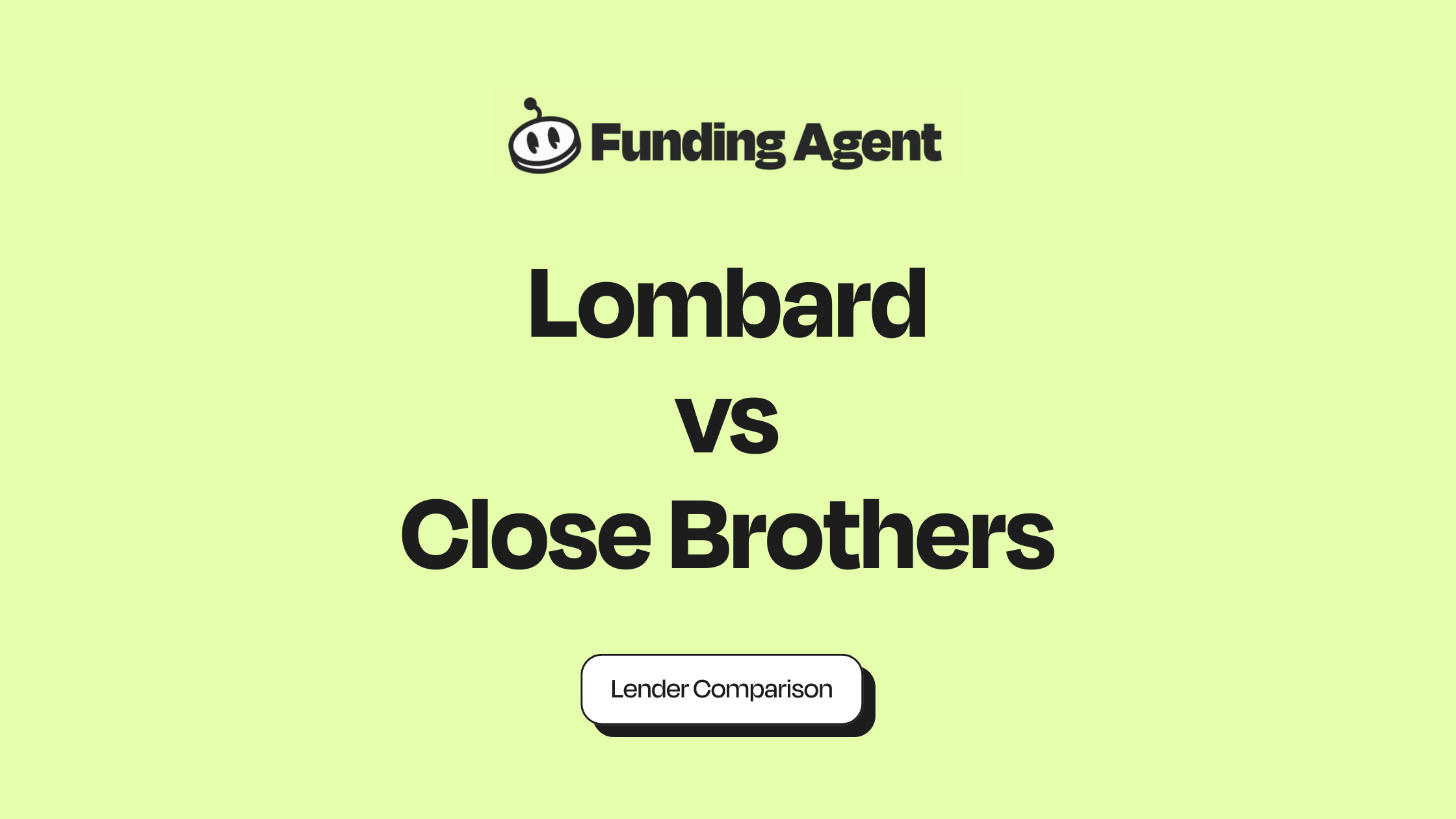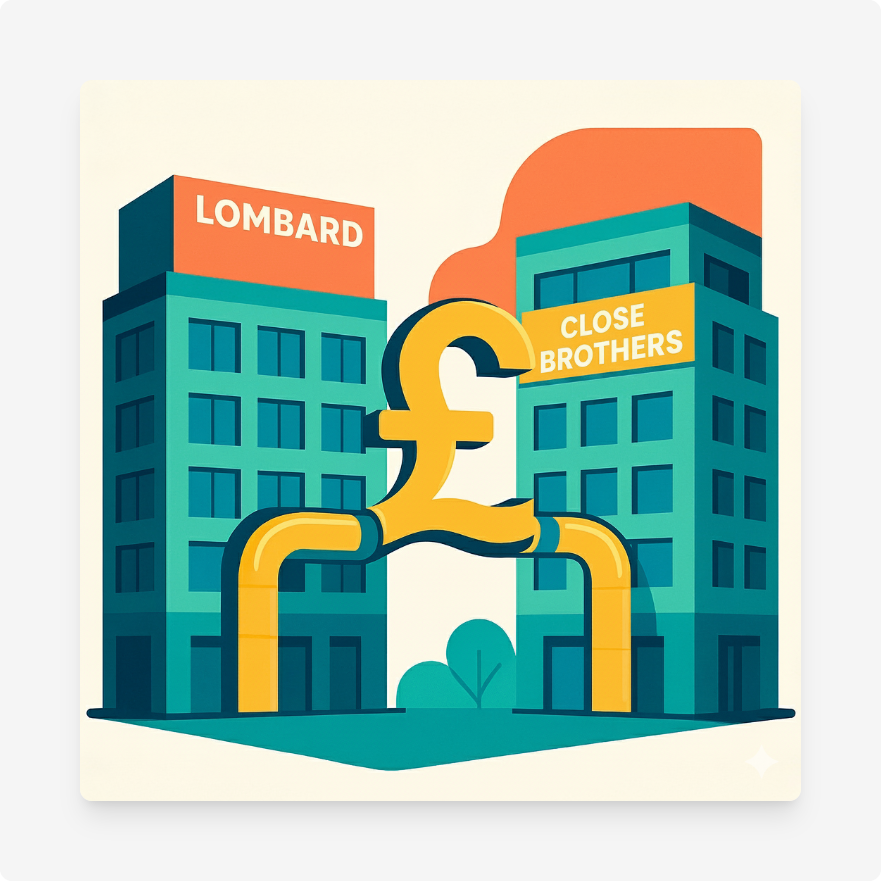

Lombard vs. Close Brothers: Compare Asset Finance


This guide compares Lombard and Close Brothers for UK SMEs that want to fund assets or unlock working capital. We look at products, costs, eligibility, speed, and where each lender fits. Both are well known brands with long track records in business finance. Picking between them matters because pricing, structure, and service model differ.

Products and Terms at a Glance
Lombard overview, loan sizes, fees, repayment style, terms, eligibility
Lombard is the asset finance arm of NatWest Group and is widely recognised as the UK’s largest asset finance provider. It offers hire purchase and leasing to help firms acquire equipment, vehicles, technology and renewable assets. Terms typically run from 12 to 84 months, with fixed or variable rates available. Eligibility is for UK businesses, subject to status and approval. Security may be required and fees may apply. If you choose hire purchase you pay an option-to-purchase fee at the end to take title.
Common use cases include new and used machinery, commercial vehicles and specialist kit. Lombard also supports sustainability projects. For first mention in this section, see asset finance for how this type of funding works at a high level.
- Facility types: Hire purchase, finance lease and operating lease.
- Term range: 12 to 84 months for many assets.
- Repayments: Regular monthly instalments. Balloons and VAT deferral may be available by arrangement.
- Fees: Arrangement and documentation fees can apply. Hire purchase usually includes an option-to-purchase fee at the end.
- Eligibility: UK businesses, over 18, subject to credit checks and affordability. Security may be required.
Assumptions: where exact sizes are not published, we use realistic SME figures and industry norms. Lombard sets pricing and eligibility case by case.
Pros of Lombard
- Clear hire purchase route to ownership at term end.
- Fixed or variable rates allow cash flow planning.
- Long terms available on many assets, which can reduce monthly cost.
- Backed by a major UK banking group with deep sector teams.
- Green and sustainability options for qualifying assets.
Cons of Lombard
- Primarily asset-backed. Not a fit if you only need pure working capital without an asset.
- Deposits and security are common, which can restrict flexibility.
- Option-to-purchase and documentation fees add to total cost on hire purchase.
- Complex or unusual assets can take longer to underwrite.
Pick the better fit today: Lombard vs Close Brothers, side by side
This dashboard turns the blog into numbers you can scan fast. Each tab shows one factor with clear scales. Read bars as ranges and dots or lines as typical points. Use it to weigh price, size, term, speed, fees and service signals for UK SMEs. If a figure is bespoke in the real world, we show a realistic industry guide so you can judge trade‑offs now.
Close Brothers overview, loan sizes, fees, repayment style, terms, eligibility
Close Brothers provides a mix of asset finance and invoice finance through specialist divisions. Asset finance includes hire purchase, finance lease, operating lease and refinance. Term lengths of three months to six years are available under current government-backed schemes, with standard commercial terms set case by case. Invoice finance can unlock up to 90% of an invoice’s value, with a service fee and a discount fee applied. Eligibility is for UK businesses, subject to status, affordability and security where required.
- Facility types: Hire purchase, finance lease, operating lease, refinance and capital release. Invoice discounting and factoring for receivables.
- Term range: Asset finance commonly up to six years depending on asset life. Invoice finance is a revolving facility, with contracts typically one to three years.
- Repayments: Monthly rentals for asset finance. For invoice finance, the funder advances a percentage now and releases the balance when customers pay.
- Fees: Asset finance includes arrangement and documentation fees. Invoice finance has a service fee plus a discount rate charged on funds in use.
- Eligibility: UK businesses, subject to credit checks, financials and sector appetite. Personal guarantees may be requested.
Assumptions: some specifics vary by division and sector. Close Brothers sets pricing and eligibility case by case.
Pros of Close Brothers
- Optional receivables facilities sit alongside asset finance, which can improve liquidity.
- Sector-led underwriting with teams that understand equipment and residual values.
- Advance rates on invoice finance can reach up to 90% on suitable ledgers.
- Refinance and capital release options for owned assets.
Cons of Close Brothers
- Fee structures on invoice finance can be harder to compare across providers.
- Personal guarantees and covenants may be required.
- As a diversified group, risk appetite can change by division and sector.
Costs and Repayments in Practice
Pricing is bespoke for both lenders. Hire purchase and leases use monthly rentals with interest set for the term. There may be documentation or arrangement fees, and a small option-to-purchase fee at the end for hire purchase. Invoice finance applies two main charges. A service fee, often a percentage of invoice value, pays for ledger administration and support. A discount rate, quoted per annum, is charged on the funds you draw until your customers pay. See our high-level product pages for asset finance and invoice finance.
Table is indicative. Exact fees depend on deal size, sector, asset, credit profile and documentation.
Worked example: Lombard hire purchase
Assume a £50,000 equipment purchase, 10% deposit, £45,000 financed over 36 months at a representative fixed rate of 8.5% per annum. Monthly payment would be about £1,420. Total repayable over the term would be about £51,139. Add the £5,000 deposit and a small option-to-purchase fee, say £100, for an all-in outlay near £56,239 across three years. This example ignores VAT timing and is for illustration only. Real quotes vary by case.
Worked example: Close Brothers invoice finance
Assume a £100,000 invoice, 90% advance, 45 days to payment. A simple discount fee at 3.0% per annum on funds in use would cost about £333 over 45 days on the £90,000 advance. If the service fee is 1.0% of the invoice value, it would be £1,000. Initial cash received is £90,000. When the customer pays, the remaining £10,000 is released less fees, so about £8,667 in this example. Total cost is about £1,333 on that invoice. Actual pricing is bespoke and depends on ledger quality, concentration, and sector.
Speed and Service
Lombard offers an online quote and application for some fixed-rate hire purchase journeys with instant decisions in many cases. For larger or complex assets, a relationship manager will handle underwriting and documentation. Decision speed then depends on asset type, supplier paperwork and financial information. In practice, straightforward asset finance can move in days while complex structures take longer.
Close Brothers is a relationship-led lender with specialist teams by sector. Asset finance decisions normally follow a review of financials, asset details and deposit. For invoice finance, onboarding includes a review of debtor book quality, contracts and verification processes. Industry timelines for asset finance range from a few days to several weeks depending on complexity. Expect faster turnaround where documentation is complete and assets are standard.
Who Each Lender Suits
Typical scenario for Lombard
A manufacturer wants a CNC machine with a five-year economic life. The business prefers predictable repayments and ownership at the end. A Lombard hire purchase fits because terms can run up to 84 months, with a final title transfer on payment of the option fee. If the project is sustainability related, green asset options may also be available. See first mention in this section of asset finance for a refresher.
Typical scenario for Close Brothers
A wholesaler needs a new warehouse forklift fleet and also wants to smooth cash flow while sales grow. Close Brothers can finance the equipment and provide invoice finance to release up to 90% of receivables. This combination supports both capital expenditure and working capital without stretching the overdraft.
How to Apply
Application steps and documentation required for each lender
Lombard
- Start an online quote for fixed-rate hire purchase. Provide asset details and business information.
- Complete the application. Lombard performs a credit search and can give an instant decision for the online journey.
- Upload documents. Expect to provide recent accounts or management information, bank statements, ID and proof of address for key principals, and the supplier quotation or pro forma invoice.
- Receive documents to sign. Pay any deposit and fees due, then the supplier is paid and you receive the asset.
Security may be required. Product and option-to-purchase fees may apply. UK businesses only. Subject to status and approval.
Close Brothers
- Speak with a sector team. Outline the asset or receivables requirement.
- Submit documents. Typical packs include recent signed accounts, bank statements, an assets and liabilities statement for owners, and supplier quotes. For invoice finance, provide ledger reports, contracts and debtor details.
- Credit assessment and offer. Terms will set the advance, the deposit or security, the term and fees.
- Documentation and payout. Funds are released to the supplier or as a receivables advance once conditions are met.
Final Verdict: Which Lender Fits Your Business Best
Choose Lombard if…
- You want classic hire purchase or leasing with the option to own the asset.
- You value longer terms to keep monthly outgoings low.
- Your priority is equipment or vehicle funding rather than receivables.
- You prefer the backing and systems of a major UK banking group.
- You are investing in green or energy efficiency assets.
Choose Close Brothers if…
- You want both asset finance and receivables solutions under one roof.
- Your ledger quality supports higher advances, up to 90% on suitable invoices.
- You value sector-specialist underwriting and flexible refinance options.
- You want to combine equipment funding with ongoing working capital.
- You prefer a relationship-led approach with hands-on onboarding.
Both lenders are credible for UK SMEs. The right choice depends on whether you need asset-backed funding, receivables funding, or both. If you are unsure, speak with an independent broker who can compare structures and costs across lenders. You can learn more at Funding Agent or send an outline via our enquiry form.
Sources
- Lombard hire purchase overview and 12–84 month terms
- Lombard leasing overview
- NatWest Group on Lombard as UK’s largest asset finance provider
- NatWest business banking on Lombard asset finance and 12–84 month guide
- NatWest sustainable finance small print on eligibility, security and fees
- Lombard FAQs on option-to-purchase fee
- Lombard insight: what is hire purchase
- Lombard brand and product overview
- Close Brothers Asset Finance product overview
- Close Brothers hire purchase explainer
- Close Brothers refinance and capital release
- Close Brothers invoice finance overview
- Close Brothers Invoice Finance product page with up to 90% advances
- Close Brothers on scheme term lengths up to six years for asset finance, up to three years for invoice finance
- NatWest press release on green loans and asset finance delivered via Lombard
- Financial Times reporting on Close Brothers capital plan and FCA motor finance review
- Financial Times coverage of Close Brothers wealth unit sale and context
- Industry guidance on typical asset finance approval timelines

